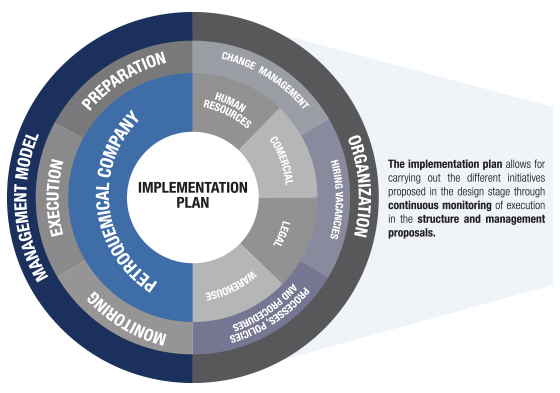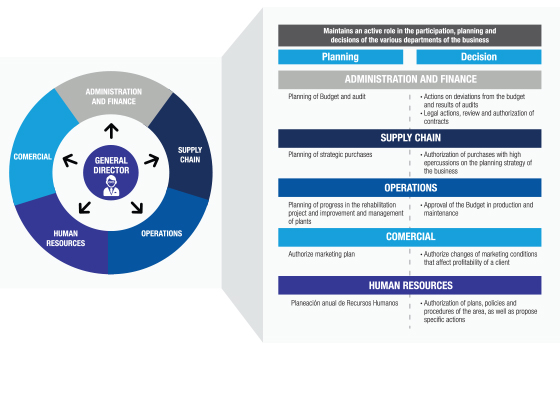GENERAL PROBLEM
One of the main challenges presented by the organization today is the alignment of its structure and management model with the objectives of its strategy. The question on:
How should the dynamic between the internal actors and their main interest groups be managed, measured and structured? It continues to be an issue in the daily action of the companies.
In addition, the organizational structure plays a key role in the definition of the identity of the companies and in the scope of the strategic objectives. Not having an organizational culture aligned to the strategic objectives causes inefficiency in the handling of resources and a lack of focus in decision making. It could be said that the cultural traits of an organization frame and give support to the daily action of their employees.
This document presents a case of success in the enabling of the organizational structure, definition of the change model, fortification of the organizational structure and administrative governance in an organization dedicated to the Petrochemical Industry.
COMPANY BACKGROUND
The creation of the company is the result of an opportunity detected among business partners for the leveraging of strategic inputs. Among the main implications of this merger is the joint operation of two plants, each of which respectively belongs to the merged companies, as well as the joint work of more than a thousand people between both companies.
SPECIFIC PROBLEM OF THE CLIENT, IN THE CLIENT’S TERMS
The merger has an important effect on the operation of the business, in addition to the complexity that it represents in the context of the petrochemical industry. After a first phase of detailed diagnosis, the opportunities detected were the following:
The organizational structure does not enable coordination between the departments, because they work in an isolated manner with little communication.
- There is a lack of communication at all levels of the organization (corporate and plants)
- There is a lack of alignment and focus in decision making due to low interaction between the departments
- The organizational structure is not well defined, since there are significant differences between the cultures of the merged companies
- There is not an established model of corporate management, since the communication channels and the exchange of information between the company and the board of directors is not well established. The definition of the model should be based on the factors of:
- Maturity of the company (Recently consolidated versus long-standing
- Profile / level of knowledge of the Shareholders
- Level of control desired / required
CHALLENGES PRESENTED BY THE CLIENT
Since it is a company comprised of private and public capital, specific challenges are presented for the management and definition of the direction of the organization. This duality in the ownership of the company affects not only tactical and strategic levels of processes, but it permeates its operations.
One of the main challenges faced by the organization was to bring production of one of its plants to optimal levels, which allowed it to position itself in the petrochemicals market in a stable manner.
To achieve this optimization of operations, it was necessary to support the processes though an improvement in the configuration of the organizational structure, greater formality in the management model and the definition of its own organizational culture.
PROPOSED METHODOLOGY
Sintec’s proposed solution consisted of an attack on four fronts of the organization:
- Proposal for a redesign of the organizational structure:
a. Identification of main areas in the organization that present opportunities in their design for the support of operational, tactical and strategic processesb. Proposal for redesign of departments using the opportunities detected - Definition and formalization of a management model
a. Mapeo de los principales procesos dentro de la organizaciónb. Definición de roles y responsabilidades para cada uno de los procesosc. Establecimiento de rutinas de gestión y monitoreo/seguimiento a compromisos
- Measurement of the organizational climate for definition of its own organizational culture
a. Diagnosis of the organizational climate at different operational levels (plants and headquarters)b. Definition of the action plan for establishment of an organizational culture which is desirable for the company - Definition of interaction between board of directors and management corps
a. Current diagnosis of the interaction between headquarters and its board of directorsb. Definition of benchmarks for interaction between headquarters and the board of directors in accordance with the characteristics of the organization and its industryc. Specific recommendations on communication between the organization’s management and the board comprised of agents of the merged companies
IDENTIFICATION OF AREAS OF OPPORTUNITY
Once the first stage of the diagnosis is complete, specific areas of opportunity were identified in the areas of structure, management and organizational culture.
- The diagnosis of the organizational culture detected low communication between the departments and the different levels of the organization, mainly between the plants and headquarters.
- Cultural conflicts were found upon integrating plant operations. These conflicts increase because the two merged companies have different contexts. On the one hand, there is a private capital organization focused on the efficiency of processes and on the other, there is a public capital organization focused on operational work with powerful intervention from workers’ unions.
- The Human Resources, Legal, Marketing and Warehouse departments presented significant opportunities in their structure, since they did not appropriately comply with their objectives and did not have a clear definition of roles and responsibilitiesa. Lack of a Human Resources department in the organization
b. Lack of an independent legal entity within the companyc. The marketing entity was shared between one of the merging companies and the company resulting from the merger, which caused situations of conflicts of interest
d. The logistics operation of the warehouse was carried out bythe Administration and Finance department, causing a lack of coordination in the operating processes of the Supply Chain
- Lack of formal meetings (management routines) for the tactical and strategic planning of the company. In addition, there was not a clear and defined framework for management and communication of the operation of the plants with the corporate headquarters.
- Lack of definition of management responsibilities and structure between corporate headquarters and the company’s board of directors
PROPOSED SOLUTION
The final proposed solution was divided according to the opportunities detected on the different fronts:
- To improve the organizational climate and formalize an independent culture in the company, an action plan was created, describing the activities to be executed by the Human Resources department. Five fronts were proposed based on a methodology of change management:
a. Sponsorship and Leadership: Promote the visible support of the General Manager and functional divisions, generating a shared vision and strengthening leadershipb. Communication: Enable the channels of communication for the flow of information to the workers of the company on time and in the correct form on the relevant topics concerning the organizationc. Training: Prepare and coordinate activities for the development of staff knowledge, abilities and attitudes
d. Organization: Know the roles and responsibilities of each of the positions in order to clarify the limits of staff functions
e. Monitoring of the Transition: Measure the level of flexibility in the face of change, such as technological implementation, redesign of processes, organizational climate, among others
- A change in the organizational structure was proposed so that it would be in accordance with the strategic objectives of the organization and would facilitate support in the operational processes:a. The creation was proposed of the Human Resources department, defining positions and key tasks to be implemented in the short, medium and long term.
b. A profile was created for a legal entity in the Administration and Finance department within the organization in order to execute and follow up on the different legal questions inherent to the petrochemical industry
c. The implementation of a marketing entity focused solely on the interests of the company, thus making strategic decision making in the Marketing Department efficient.
d. The roles and responsibilities of the Warehouse are defined, leaving the custody and planning of raw materials to the Supply Chain department and the control in Administration and Finance
- A management model was designed that aligns and simplifies the responsibilities assigned to each of the positions that are involved in the different processes of the organization. Likewise, coordination mechanisms were defined and formalized that will facilitate management and decision making in each process:a. Management routines were designed for each area, naming people in charge, objectives and results for each of them.
b. Monitoring tools were created to follow up on and consolidate the commitments generated through management routines.
- A management model was designed between corporate headquarters which considers:a. Functions to perform by the members of the governing committee (corporate headquarters and board)
b. Members (roles and responsibilities)
c. Topics to be handled in each meeting
d. Frequency of meetings and enablers (min. and ad hoc reports)
CONCLUSIONS
The structure, management and culture of an organization are strategic topics that should uphold the day-to-day operations within the companies. The organizational challenges for the fulfillment of the strategic objectives and the dynamic environment in which companies act demand a greater degree of formalization and coordination between all company departments. The design proposed for this organization of the petrochemical industry allows for better configuring the processes, thus facilitating anticipation of future challenges and focus on the present goals.
ANNEX
Annex 1) Implementation Model for Management and Organizational Structure
Annex 2) Management Model for the Director General

